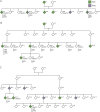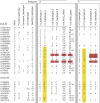C9orf72 Repeat Expansion Discordance in 6 Multigenerational Kindreds
- PMID: 38149039
- PMCID: PMC10751011
- DOI: 10.1212/NXG.0000000000200112
C9orf72 Repeat Expansion Discordance in 6 Multigenerational Kindreds
Abstract
Background and objectives: A hexanucleotide repeat expansion in the noncoding region of the C9orf72 gene is the most common genetically identifiable cause of amyotrophic lateral sclerosis (ALS) and frontotemporal dementia in populations of European ancestry. Pedigrees associated with this expansion exhibit phenotypic heterogeneity and incomplete disease penetrance, the basis of which is poorly understood. Relatives of those carrying the C9orf72 repeat expansion exhibit a characteristic cognitive endophenotype independent of carrier status. To examine whether additional shared genetic or environmental risks within kindreds could compel this observation, we have conducted a detailed cross-sectional study of the inheritance within multigenerational Irish kindreds carrying the C9orf72 repeat expansion.
Methods: One hundred thirty-one familial ALS pedigrees, 59 of which carried the C9orf72 repeat expansion (45.0% [95% CI 36.7-53.5]), were identified through the Irish population-based ALS register. C9orf72 genotyping was performed using repeat-primed PCR with amplicon fragment length analysis. Pedigrees were further investigated using SNP, targeted sequencing data, whole-exome sequencing, and whole-genome sequencing.
Results: We identified 21 kindreds where at least 1 family member with ALS carried the C9orf72 repeat expansion and from whom DNA was available from multiple affected family members. Of these, 6 kindreds (28.6% [95% CI 11.8-48.3]) exhibited discordant segregation. The C9orf72 haplotype was studied in 2 families and was found to segregate with the C9orf72-positive affected relative but not the C9orf72-negative affected relative. No other ALS pathogenic variants were identified within these discordant kindreds.
Discussion: Family members of kindreds associated with the C9orf72 repeat expansion may carry an increased risk of developing ALS independent of their observed carrier status. This has implications for assessment and counseling of asymptomatic individuals regarding their genetic risk.
Copyright © 2023 The Author(s). Published by Wolters Kluwer Health, Inc. on behalf of the American Academy of Neurology.
Conflict of interest statement
M. Ryan, M.A. Doherty, A. Al Khleifat, E. Costello, J. Hengeveld, M. Heverin, and R.L. McLaughlin report no disclosures relevant to the manuscript; A. Al-Chalabi reports consultancies or advisory boards for Amylyx, Apellis, Biogen, Brainstorm, Cytokinetics, GenieUs, GSK, Lilly, Mitsubishi Tanabe Pharma, Novartis, OrionPharma, Quralis, Sano, and Sanofi; O. Hardiman declares personal fees from the publisher Taylor & Francis, Cytokinetics, and Wave Pharmaceuticals. Go to Neurology.org/NG for full disclosures.
Figures



Similar articles
-
Clinical characteristics of patients with familial amyotrophic lateral sclerosis carrying the pathogenic GGGGCC hexanucleotide repeat expansion of C9ORF72.Brain. 2012 Mar;135(Pt 3):784-93. doi: 10.1093/brain/awr366. Brain. 2012. PMID: 22366794 Free PMC article.
-
Analysis of C9orf72 repeat expansion in 563 Japanese patients with amyotrophic lateral sclerosis.Neurobiol Aging. 2012 Oct;33(10):2527.e11-6. doi: 10.1016/j.neurobiolaging.2012.05.011. Epub 2012 Jun 21. Neurobiol Aging. 2012. PMID: 22727276
-
Aggregation of neurologic and neuropsychiatric disease in amyotrophic lateral sclerosis kindreds: a population-based case-control cohort study of familial and sporadic amyotrophic lateral sclerosis.Ann Neurol. 2013 Nov;74(5):699-708. doi: 10.1002/ana.23969. Epub 2013 Sep 10. Ann Neurol. 2013. PMID: 23836460
-
Genetic counseling for FTD/ALS caused by the C9ORF72 hexanucleotide expansion.Alzheimers Res Ther. 2012 Jul 19;4(4):27. doi: 10.1186/alzrt130. eCollection 2012. Alzheimers Res Ther. 2012. PMID: 22808918 Free PMC article. Review.
-
Links Between the C9orf72 Repeat Expansion and Psychiatric Symptoms.Curr Neurol Neurosci Rep. 2019 Nov 26;19(12):93. doi: 10.1007/s11910-019-1017-9. Curr Neurol Neurosci Rep. 2019. PMID: 31773397 Review.
Cited by
-
Penetrance and pleiotropy in ATXN2-related amyotrophic lateral sclerosis.Eur J Hum Genet. 2025 Sep;33(9):1093-1095. doi: 10.1038/s41431-025-01882-1. Epub 2025 Jun 2. Eur J Hum Genet. 2025. PMID: 40456951 Free PMC article. No abstract available.
-
Dynamics of Onset and Progression in Amyotrophic Lateral Sclerosis.Brain Sci. 2025 Jun 3;15(6):601. doi: 10.3390/brainsci15060601. Brain Sci. 2025. PMID: 40563773 Free PMC article. Review.
-
Amyotrophic lateral sclerosis caused by hexanucleotide repeat expansions in C9orf72: from genetics to therapeutics.Lancet Neurol. 2025 Mar;24(3):261-274. doi: 10.1016/S1474-4422(25)00026-2. Lancet Neurol. 2025. PMID: 39986312 Free PMC article. Review.
-
Molecular pathology, developmental changes and synaptic dysfunction in (pre-) symptomatic human C9ORF72-ALS/FTD cerebral organoids.Acta Neuropathol Commun. 2024 Sep 18;12(1):152. doi: 10.1186/s40478-024-01857-1. Acta Neuropathol Commun. 2024. PMID: 39289761 Free PMC article.
References
Grants and funding
LinkOut - more resources
Full Text Sources
Miscellaneous
